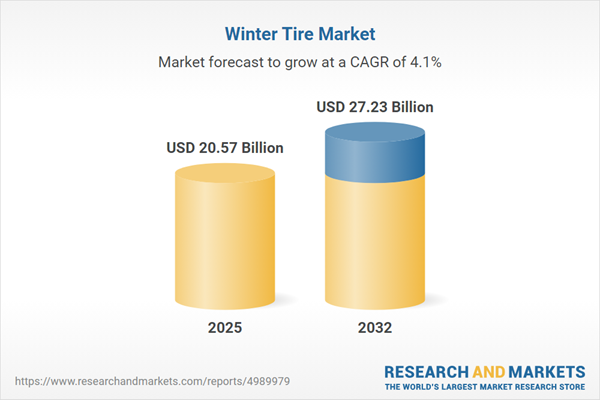Speak directly to the analyst to clarify any post sales queries you may have.
The winter tire market is adapting rapidly as regulatory shifts, variable climate trends, and advanced technology requirements reshape buyer demands. Senior decision-makers face an evolving landscape where informed strategies and agile operations are paramount for sustained growth and risk reduction.
Winter Tire Market Snapshot
The global winter tire market is demonstrating steady expansion, valued at USD 19.75 billion in 2024 and projected to grow to USD 20.57 billion by 2025, with a further anticipated increase to USD 27.23 billion by 2032. This sustained trajectory, featuring a compound annual growth rate (CAGR) of 4.09%, underscores ongoing commitments to next-generation tire compounds and research and development initiatives.
Regulatory changes on both global and regional scales are prompting tire manufacturers to diversify their product portfolios. Innovation is centered on winter tire models engineered to meet the distinct needs of varied climates and evolving vehicle requirements, securing both compliance and market accessibility for key industry players.Scope & Segmentation of the Winter Tire Market
- Type: Studded tires are optimized for exceptional grip in icy, severe winter conditions. Studless tires provide consistent traction across diverse cold-weather terrains, expanding their utility beyond traditional winter strongholds.
- Construction: Bias-ply tires offer resilience suitable for less extreme climates, while radial designs prioritize adaptability and comfort over mixed terrains and temperatures, aligning with modern driving preferences.
- Vehicle Type: The market serves passenger vehicles, SUVs, light trucks, and commercial vans. Each category demands tailored performance enhancements for road safety and operational reliability throughout colder months.
- Application: Offerings support both original equipment supply to automakers and a dynamic aftermarket presence, extending availability through dealerships, online channels, and specialty outlets.
- Distribution Channel: Products reach end users via direct sales, independent retail partners, and e-commerce, with after-sales support pivotal in ensuring ongoing tire functionality and reduced operational interruptions.
- End User: Solutions benefit private motorists and commercial fleets, strengthening traction and safety in challenging winter environments and minimizing disruption during peak seasonal operation.
- Region: Demand is concentrated in the Americas, EMEA, East Asia, and Oceania. Regional regulations and climate-specific drivers influence supply chain strategies, product customization, and speed to market, making local adaptation a key differentiator.
- Leading Companies Covered: Major manufacturers such as Bridgestone, Michelin, Continental, Goodyear, Pirelli, Yokohama, Hankook, Nokian Tyres, Sumitomo, and Kumho Tire continue to shape industry standards through advanced product development and competitive differentiation.
Key Takeaways: Strategic Insights for Senior Leaders
- Breakthroughs in rubber chemistry and tread patterns have elevated expectations for multi-season performance and enhanced vehicle safety.
- Emerging winter tire innovations include specific enhancements for electric vehicles, such as optimized efficiency and minimized noise, to address new mobility trends in both private and commercial settings.
- Smart tire technologies with embedded sensors offer predictive maintenance for fleets, decreasing unplanned downtime and increasing seasonal reliability.
- Manufacturers are prioritizing agile production and inventory strategies, improving responsiveness to unpredictable winter conditions and evolving regulations.
- Sustainable sourcing methods, along with increased adoption of recycled and bio-based materials, enable companies to create environmentally responsible products and navigate tightening global standards.
- Strong supply chain oversight ensures business continuity and quick adaptation to logistical or regulatory challenges, reinforcing resilience across varying markets.
Tariff Impact
Recent tariff adjustments in the United States are adding complexity to global trade across the winter tire sector. Leading industry players are deepening supplier relationships and focusing on operational stability to control costs and maintain reliable product delivery amid shifting trade conditions.
Methodology & Data Sources
This analysis integrates insights from interviews with technical experts, leading suppliers, and fleet managers. Supporting data stems from rigorous surveys, financial benchmarking, and patent reviews to inform scenario development and provide stakeholders with actionable guidance in the winter tire market.
Why This Report Matters
- Equips decision-makers with targeted regulatory and technological perspectives, enabling proactive responses to shifting market risks and opportunities.
- Empowers supply chain, procurement, and operations professionals to strengthen compliance and operational efficiency in the face of new regulatory demands.
- Provides frameworks for growth identification and risk management as business models align with both market evolution and changing customer priorities.
Conclusion
This report provides senior leaders with practical segmentation, strategic guidance, and actionable insights to drive investment, operational improvement, and adaptability in a dynamic winter tire market.
Additional Product Information:
- Purchase of this report includes 1 year online access with quarterly updates.
- This report can be updated on request. Please contact our Customer Experience team using the Ask a Question widget on our website.
Table of Contents
3. Executive Summary
4. Market Overview
7. Cumulative Impact of Artificial Intelligence 2025
Companies Mentioned
The companies profiled in this Winter Tire market report include:- Bridgestone Corporation
- Compagnie Générale des Établissements Michelin S.C.A.
- Continental Aktiengesellschaft
- The Goodyear Tire & Rubber Company
- Pirelli & C. S.p.A.
- Yokohama Rubber Co., Ltd.
- Hankook Tire & Technology Co., Ltd.
- Nokian Tyres PLC
- Sumitomo Rubber Industries, Ltd.
- Kumho Tire Co., Inc.
Table Information
| Report Attribute | Details |
|---|---|
| No. of Pages | 187 |
| Published | November 2025 |
| Forecast Period | 2025 - 2032 |
| Estimated Market Value ( USD | $ 20.57 Billion |
| Forecasted Market Value ( USD | $ 27.23 Billion |
| Compound Annual Growth Rate | 4.0% |
| Regions Covered | Global |
| No. of Companies Mentioned | 11 |









